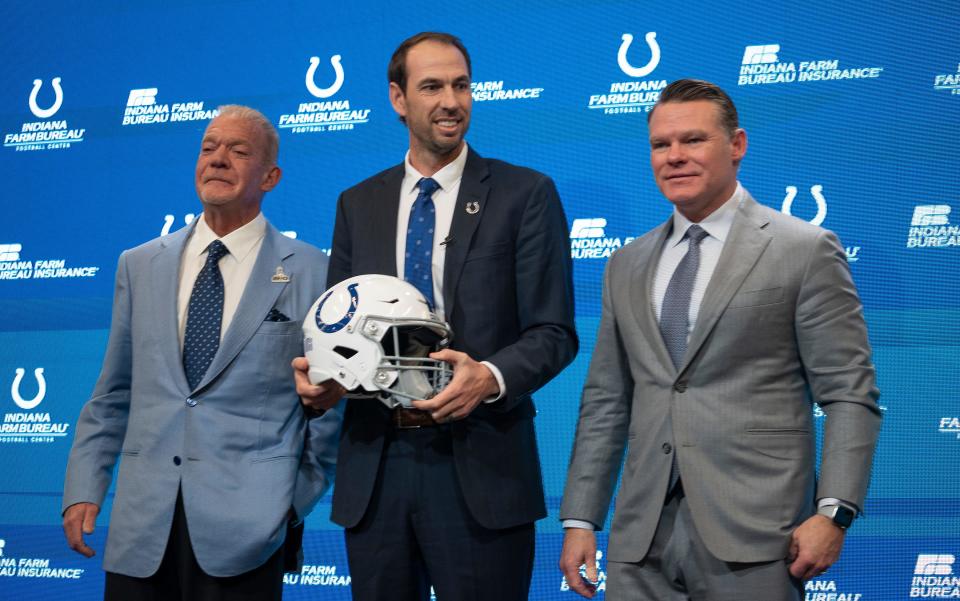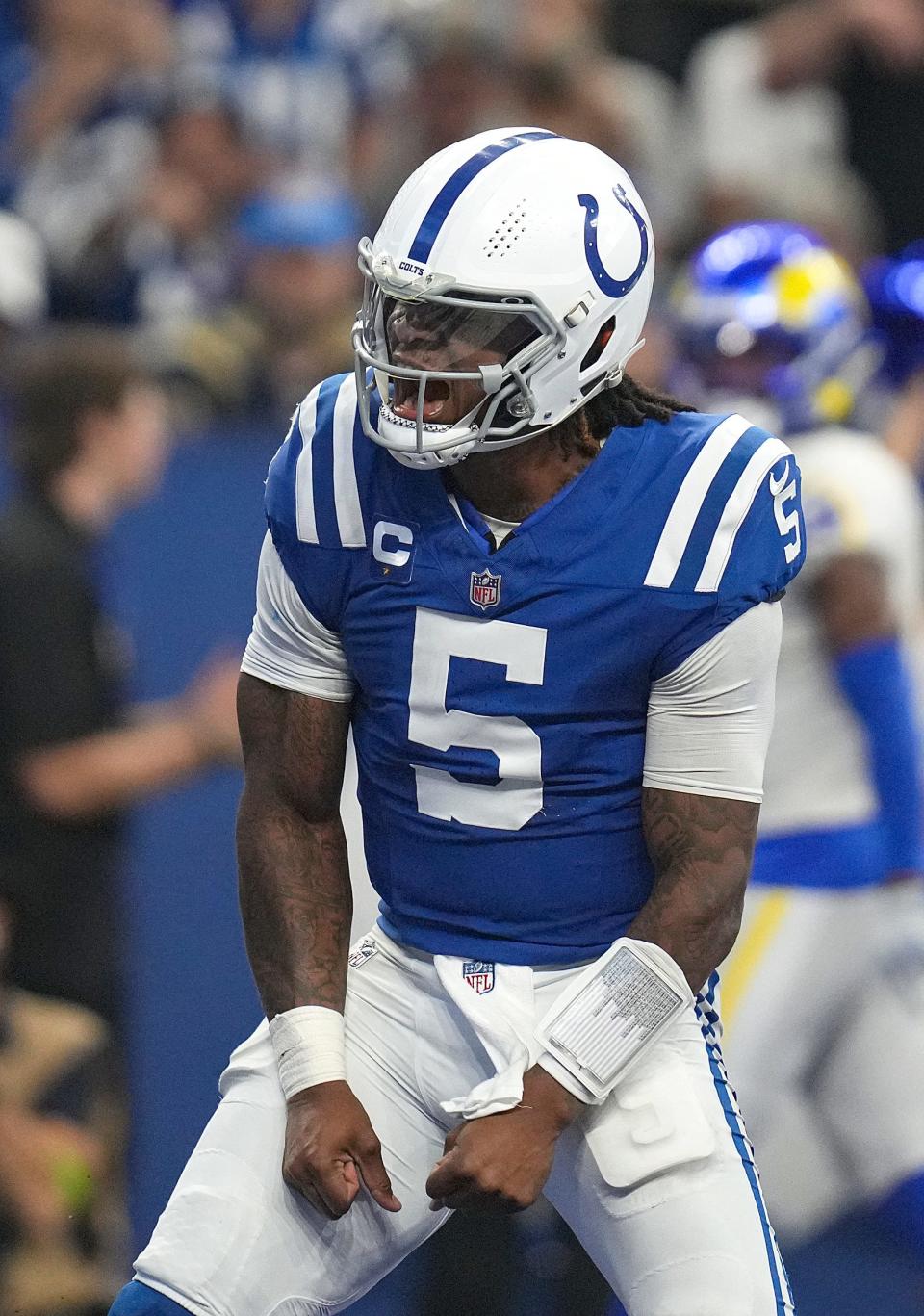AFC South teams keep adding star players to support young QBs. So why aren't the Colts?
ORLANDO -- The landscape of the AFC South changes a little more with each passing week.
One day, it's Danielle Hunter inking a two-year, $48 million fully guaranteed deal with the Texans.
Then it's Calvin Ridley receiving $23 million per season across four years from the Titans.
It can be Arik Armstead finding $28 million guaranteed from the Jaguars, or the Titans trading for L'Jarius Sneed, or the bombshell that happened Wednesday, when the Texans traded for four-time Pro Bowl wide receiver Stefon Diggs.
The moves to acquire outside players have been fast and furious since free agency began, and they involve each AFC South team except for the Colts.
These four franchises set out this spring with the same challenge: They all had a starting quarterback on a rookie contract who is no longer a rookie. Because of it, they had money to burn in a year with the largest salary cap increase in NFL history. And they all needed to find ways to support the development of their young passers.
But so far, the division has featured the Jaguars, Texans and Titans going after multiple top-flight outside acquisitions and the Colts focused solely on bringing back their own players.
"We did spend," Colts general manager Chris Ballard said. "We just didn't spend on the outside."
In bringing back every single in-house free agent starter and a host of backups, the Colts have pledged more than $200 million in total contract dollars to players such as Michael Pittman Jr., Zaire Franklin, Kenny Moore II, Grover Stewart, Tyquan Lewis and Rigoberto Sanchez from last year's 9-8 squad.

It's another way their approach differs from the rest of the division, which let players with high market value walk. The Jaguars lost a 1,000-yard receiver in Ridley and a Super Bowl champion cornerback in Darious Williams. The Titans moved on from an 11.5-sack defensive end in Denico Autry, a 163-tackle linebacker in Azeez Al-Shaair and an 1,100-yard rusher in Derrick Henry. The Texans parted ways with a 12.5-sack pass rusher in Jonathan Greenard and a six-sack veteran in Sheldon Rankins.
Meanwhile, the Colts' biggest losses were Gardner Minshew and Zack Moss, who could only have returned to backup roles.
It has been Ballard's philosophy and owner Jim Irsay's practice of building through the draft and retaining players taken to the extreme. But it has come, so far, at the cost of adding any starters from the outside.
They have made two outside acquisitions so far in quarterback Joe Flacco and defensive tackle Raekwon Davis. Those two totaled $13.5 million in guarantees, but both are locked into backup roles.
After accounting for the one-year, $7.7 million deal Blackmon signed Tuesday, the Colts are sitting on just under $10 million in cap space for 2024. It's a little more than they'll need to pay the draft class. They could create more through an extension, such as one for Pro Bowl defensive tackle DeForest Buckner, but those maneuvers have not fit how the Colts have operated under Ballard or under Irsay.
It's becoming increasingly possible, if not likely, that the only new starters the Colts will add will come in this month's NFL Draft.
"That's where I go into the, 'Who?'" Ballard said. "OK, go spend. On who?
"And that's OK. That's what makes our game great. We get to talk about it and debate. At the end of the day, we thought our free agents were good players. We took a shot on a couple. We got some that we're excited about and didn't get the other ones."
Ballard's issue with free agency has long been that it doesn't feature premium talent because teams don't let those kinds of players get to free agency. He believes they instead exist in the draft, and not just at the top. The Colts have the No. 15 pick this year, with a wide receiver class that is considered one of the best ever.
If they have a swing in them, that is the most likely place for it to happen.
'Different is not always better'
This year, the Colts identified one free agent as premium talent. That was Hunter, who is coming off his fifth season with double-digit sacks. They made a push for him, but he wound up signing the fully guaranteed deal to play in Houston, where he grew up.
Losing out on Hunter became a double-whammy when the Texans were the team to land him, as it adds another star the Colts must contend with in order to chase down the reigning AFC South champions.
The Colts were not as ready to invest in Sneed, whom the Titans landed for a 2025 third-round pick before signing him to a four-year, $76.4 million deal. The Colts inquired about Sneed as a potential free agent but did not make any attempts to trade for him once the Chiefs applied the franchise tag, a team source told Indy Star.
Sneed is a traveling cornerback in his prime who has won back-to-back Super Bowls with some splash plays in the postseason. But he isn't a bulletproof player, and those looking for holes could point out that he's already 27, hasn't reached a Pro Bowl or All-Pro team and has a history of holding penalties.
"Different is not always better," Ballard said about this year's free agent class.
If the Colts are only going to look for perfect players in free agency or trades, they're never going to add very many. It's not just that those players don't become available but that in a physical sport that ages and exposes players, very few perfect players actually exist.
Risk comes with every signing, the same way it comes with projecting any player from the NFL Draft. But one of those additions costs liquid cash and the other has prices suppressed for four-year windows by the league's Collective Bargaining Agreement.
The Colts' approach to this offseason appears to be three-pronged and unified. Ballard has never invested much in outside free agents, outside of an occasional short-term deal such as Stephon Gilmore, Denico Autry or Justin Houston. A lifelong scout with a passion for trading down for more picks, Ballard is staunch on building through the draft.
Irsay writes the checks and green-lights his front office to make sizable outside acquisitions. He gives them the numbers they can operate with. Aside from a brief foray into free agency in 2015 with a class of Frank Gore, Trent Cole and Andre Johnson, he has not historically spent on players outside of his building.
And though Steichen hails from arguably the league's most aggressive franchise in the Eagles, he has raved about the growth of young internal players such as cornerbacks JuJu Brents and Jaylon Jones. His messaging this offseason has been clear:
"I believe in continuity," Steichen said.
Bringing back defensive coordinator Gus Bradley is that. Re-signing and extending five of Bradley's starters is that, too.
But the Colts are banking on one giant addition, in a way.

How Anthony Richardson and Jonathan Taylor can explode Colts ceiling
That's the duo of Richardson and Jonathan Taylor in the backfield.
Though neither player is actually new to the roster, they are new to each other. Taylor missed the first four games last season following his contract dispute with the club. Following a three-year, $42 million deal -- yet another in-house signing -- he debuted in limited fashion in Week 5 against the Titans, which was the game where Richardson suffered the AC joint sprain in the second quarter.
They played two snaps together, with zero exchanges.
But in them, the Colts have a backfield with two players who measure at least 225 pounds and can run at 4.4-second 40-yard dash speed or better. The quarterback became the first player in NFL history to rush for four touchdowns in his first three games. The running back won the NFL rushing title in 2021.
The fit on paper, with the return of what the Colts have on the offensive line and in the receiving corps, is enough to excite the franchise about the ceiling of the club. But it's still theoretical, as Richardson has thrown 84 career passes, Taylor has missed 13 games in two seasons and the two have never so much as had a training camp handoff together.
It makes their window a different evaluation than the Jaguars' with Trevor Lawrence or the Texans' with CJ Stroud, though it is similar to the Titans' with Will Levis, who started just nine games with only flashes, at best, as a rookie.
"We’re encouraged about what we saw," Ballard said of Richardson. "Let’s not go crown him."
But by rolling back the team around Richardson, the Colts could run the risk of doing that. If they can't make immense strides on defense, they could find themselves not just hoping the Richardson-Taylor backfield is explosive but demanding it to be, given that this year's slate of opposing passers lines up to be far more challenging.
The path in the AFC South and in the AFC at large goes through star quarterbacks and explosive offensive weapons. After years of searching, the Colts have reason to believe they can become one of those teams the others have to go through.
They're trying to get there in their own unique way.
"It’s time for us to put some banners up now. It’s time for us to accomplish something," said Franklin, one of the players the Colts brought back on a three-year, $31.3 million extension.
"We’ve got to leave here with something other than good memories.”
Contact Nate Atkins at natkins@indystar.com. Follow him on Twitter @NateAtkins_.
This article originally appeared on Indianapolis Star: Why aren't the Colts adding outside starters?

